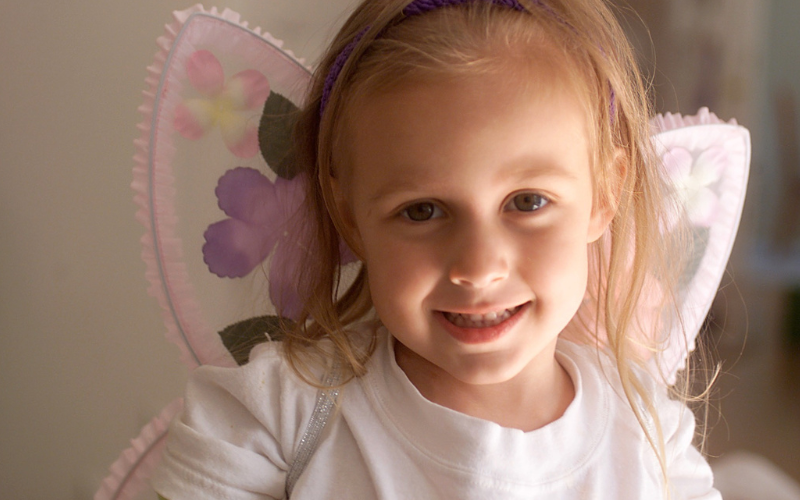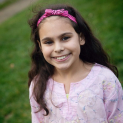
Anna Healey, pictured above, battled neuroblastoma. The cancer ultimately took her life just two months before her 10th birthday.
By: Trish Adkins
ALSF-funded researcher Linda Malkas is leading an early phase adult clinical trial that holds promise for kids battling neuroblastoma and other solid tumors.
It’s 2005 when photojournalist Steve Healey is late to his appointment to photograph cancer researcher Dr. Linda Malkas at the Indiana University School of Medicine. Malkas, a native New Yorker, is really annoyed, but Steve looks distraught. Swallowing her impatience, she asks him, “Are you alright?”
Healey, at first, says yes. But, then, he says no, his 8-year-old daughter, Anna, is an oncology patient at Riley Children’s Hospital right across the street. Anna had been battling neuroblastoma for almost five years — relapse after relapse, failed treatment after failed treatment. “We’re running out of options,” Healey said.
“That took the steam right out of me. I sat for the picture and as Steve was putting his cameras away, he goes, so what is it that you do?” said Malkas.
Two hours later, Malkas had walked Healey through all her charts and graphs of the work she was doing studying breast cancer and a strange, mutated protein called proliferating cell nuclear antigen (PCNA). It’s another year until Malkas sees Healey again. This time, he’s on time and he has a check for $30,000 and a plea: please, study neuroblastoma.
Malkas, who had devoted more than a decade to breast cancer, says yes.
Healey’s daughter, Anna, exhausting all available treatments, would die a few months later on March 14, 2006, just two months shy of her 10th birthday.
For the next 17 years, Malkas made good on her promise. In 2019, Malkas received a Reach Grant from Alex’s Lemonade Stand Foundation (ALSF). The Reach grant provides investigators with funding at a critical point in the development of a therapy — supporting the gathering of preclinical data that is needed to support the initiation of a clinical trial. Using ALSF support, Malkas moved her study from bench to bedside, opening an early phase clinical trial at City of Hope for a pill called AOH1996. Named for Anna Olivia Healey, the pill is given twice a day, and in lab studies it decimated cancer cells and left healthy cells alone. It’s being called “the holy grail” of cancer treatments. It is also Malkas’s very first clinical trial.
“I wanted to do something in the name of that little girl, so I pivoted. I know it sounds crazy. I said, I'm going to do this. I don't know how I'm going to do it, but I'm going to do it,” said Malkas.
Targeting that strange protein
AOH1996 works by targeting that strange, mutated protein that Malkas was studying in the early 2000s. Every cell in the human body is adorned with PCNA, which resembles a Christmas wreath — a circle shape with irregular, pointed edges and a hole in the middle, decorated with ornamental amino acids. This protein encircles cellular DNA, like a wreath around a prize-winning racehorse’s neck, directing critical repair and replication operations. When PCNA encircles a cancer cell it changes its ornamentation a bit, becoming what Malkas calls caPCNA and uses its reparation power for cancer, facilitating repair and spread throughout the body. For years this protein was considered undruggable, because no one could find a drug that would kill caPCNA, while leaving healthy cells alone.
Malkas was determined to find a drug that would work. She is quick to point out that she is not a medicinal chemist and really had no idea how to develop a drug on her own. “This was a real jumping off into the deep end of the pool without knowing how to swim situation,” she said.
Malkas took the $30,000 check from Healey, which was raised through the family’s foundation, the A.N.N.A. Fund. Friends of the Healey’s started the Fund when Anna was alive, and eventually, the funds were used to help families with household expenses during their child’s treatment or for travel funds for families who needed to go far away for treatment. They raised money through a series of grassroots events that included galas, motorcycle rallies and selling fresh corn from the Healey’s family farm. That small gift opened the door for more grants, including the ALSF funding.
“There are hearts in those dollars,” said Malkas. So, she took those hearts to lab after lab asking for help identifying potential compounds that could target PCNA. After lots of closed doors, a small lab in Albany helped Malkas and screened thousands of potential compounds that could be turned into drugs for PCNA. From that list, the lab narrowed it down to 53.
Malkas brought that list to the A.N.N.A. Fund gala and showed Steve Healey, telling him no matter how far this research went, the drug would be named for Anna.
A peculiar cancer
Neuroblastoma is diagnosed almost exclusively in children. It is an easy cancer to treat — often responding in part to treatment — but a difficult one to cure.
Anna’s mom, Barbara Healey remembers sitting in the hospital after Anna’s diagnosis. “They give you a pamphlet entitled: ‘What is neuroblastoma?’ In that pamphlet a phrase jumped out at me: ‘it’s a peculiar cancer.’ That wasn’t the story we wanted to read,” said Barbara.
At the time of Anna’s diagnosis in 2000, the five-year survival rate for neuroblastoma was under 70%. Anna lived beyond five years, but only by 11 months.
Initial treatment options for Anna were limited to surgery, radiation and chemotherapy. Once she relapsed, the options narrowed and doctors looked for different routes, but the path was unclear.
“I remember thinking, so what are those different routes? And then looking and realizing it was pretty limited,” said Barbara.
The family traveled to hospitals all over the country trying trials for stem cell transplants and MIBG therapy, a type of radioactive therapy that requires isolation during treatment. Nothing worked forever. In between treatments, the Healey’s did everything they could to give Anna extraordinary experiences — traveling to Europe and to the zoo to feed zebras and to the mountains to learn to ski — and also regular experiences like going to school and playing on the softball team.
But then the cancer became more aggressive and invaded Anna’s spine, requiring an invasive surgery that limited her mobility and required her to wear a brace. Time with Anna was growing shorter.
“The second worst day of your life is when the doctor tells you there is nothing more they can do for your child. The worst day is when they die,” said Healey.
Finding more funding
After screening the compounds and seeing if any would work against PCNA, Malkas knew she needed to find a mechanism and funding to create an actual drug that could be used in studies. Pitches to pharmaceutical companies were rejected. Funding sources for childhood cancer research were limited.
Then, an invitation arrived from City of Hope to speak about her breast cancer research. While speaking there, Malkas discovered that the hospital had its own drug manufacturing infrastructure.
“I knew I had to work there,” said Malkas. She left her speaking engagement with a job offer and started her new lab at City of Hope in 2011. Over the next ten years, Malkas, a former breast cancer researcher, would be awarded grants for childhood cancer work. She’d also be awarded a substantial grant from the Department of Defense and form her own drug development company.
Then, with the support of her medicinal chemist colleagues at City of Hope, she began testing AOH1996 in models of neuroblastoma, breast and small cell lung cancer tumors. The models stopped replicating and disappeared without causing any discernable toxicity to healthy cells. Malkas called it a eureka moment and realized AOH1996 was a promising, viable option.
The day she learned that the FDA had approved the Phase 1 clinical trial for AOH1996, a colleague sent her a six-page GANTT Chart with all the steps it takes to get from the lab to a drug in a clinical trial.
“There were at least 350 steps on there. I said to him, I am so grateful you've never sent this to me before. I would never have done it,” said Malkas.
Promising trial, with a long road ahead
The trial, which opened in September 2022, has enrolled eight adult patients with relapsed solid tumors, with an aim to find the highest, safest dose of the pill. Later this year, Malkas expects the trial to open to more adult patients.
And while the pills worked in models, translating to human beings isn’t always completely successful. Malkas is optimistic and sees AOH1996 as potential pill that could be added to existing therapies, enhancing and strengthening their ability to fight cancer as a team.
While the adult trial is in progress, Malkas is back in her lab working on a liquid formulation of AOH1996, that could be used to treat the youngest children who are not able to swallow pills.
For the Healeys, watching this story unfold has been surreal.
“Research isn’t years, it’s decades. And I know it was crazy to watch the news boomerang around the world when Linda opened the study, and we are thrilled that it’s made it to human trials. But, we know it is a much longer runway until it is a viable drug,” said Barbara Healey.
To date, ALSF has funded more than 1,500 critical research projects leading toward new treatments and cures for childhood cancer. These projects are only because of generous donations from supporters like you. Your donations fund research that brings better treatments and cures to children with cancer.

